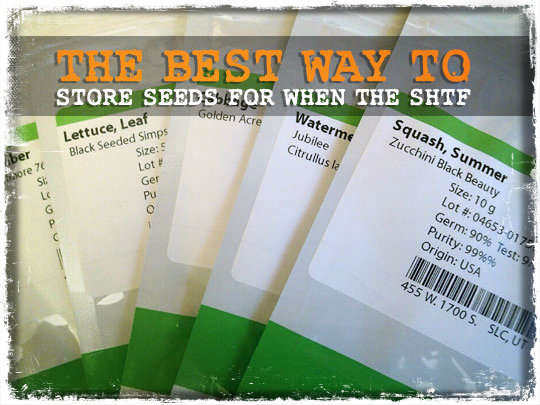
First, decide what seeds you want to store based on your personal preference, in other words, what do you and your family like to eat. Secondly, consider seeds that can be stored and used for bartering. Even though you may not care for beets and carrots, for example, others would, and thus, you have currency for trade during a crisis. Lastly, look at nutritional value, the biggest nutritional bang for your buck in other words.
Seed Sources
The Internet is full of retailers and others that will get you started on your seed bank, at a cost of course, or you can simply buy seed packets at your local retailer You can even purchase a “seed bank” that can be stored for years as insurance against a calamity.
You can begin harvesting your own seeds, as well, from heirloom plants right now. However, the variety is limited to just what you have grown, so you may have to purchase seeds to expand your variety, and again think about bartering and nutritional value.
Heirloom, open pollinated seeds are ideal because once mature, the seeds can be harvested, dried and stored for future seasons. You cannot harvest seeds from hybrid plants, because generally the first generation of seeds from a hybrid plant is sterile. You need a renewable food source and so need plants that can provide you with seeds for years to come.
Storing Seeds
Moisture, sunlight, artificial light, temperature swings, and oxygen are the enemy of seeds. Glass containers are ideal for storage containers if kept in a relatively temperature controlled area in a dark place, because there is no chance of permeation through the glass. Seeds you harvest yourself must be processed properly before storing.
How long you can store seeds depends on the moisture content when stored, the temperature, the amount of light, and the seeds themselves. If you purchase seeds from a retailer, you really have no way of knowing whether the seeds were stored properly, and for how long, so before buying do some research on the company and ask questions.
You may not know how long the retailer has stored them so look for expiration dates on the packets, and some packets will not have expiration dates, but instead may have harvest or package dates.
The following is an estimate only on the viability of seeds, and remember much depends on how they are stored.
- Beans up to 3 Years
- Beets up to 2 Years
- Carrots 3 Years
- Corn Is 2 Years
- Cucumbers up to 5 Years
- Lettuce Is 3 Years
- Peas – 3 Years
- Peppers up to 2 Years
- Pumpkins 4 Years
- Radishes up to 5 Years
- Spinach – 5 Years
- Tomato up to 4 Years
- Watermelon 4 Years
Refrigerated between 40 and 50° F is a good place to start. You can freeze seeds, but if they have high moisture content this can kill the seeds. Seeds with 50 percent moisture content, for example, would die if frozen, while seeds at 10 percent can be frozen for years. Seeds need a certain amount of moisture content to stay viable, however. Too dry is just as deadly.
Store in glass jars, Mylar bags, metal cans, or vacuum seal your seeds and place in a rodent and insect proof container if stored out of refrigeration. Add an oxygen absorber to each glass container. Store in a dark place where you do not expect temperature swings, hot in the summer and cold in the winter. The containers must be such that insect infestations are not possible, so cloth sacks, cardboard, paper, and even some plastic containers will not prevent infestation.
Metal cans, for example, provide an absolute barrier against rodents, insects, light, and if properly sealed against oxygen, gas, and moisture as well. Glass and vacuumed sealed bags will not provide a barrier against light, so consider storage areas before deciding on containers. Mylar will provide a barrier against gases, oxygen, and moisture in the short-term, but over time the material will allow a certain amount of moisture and gases to permeate through the material.
Test Your Seeds for Germination
Not every seed will germinate so if you want, or need 10 tomato plants, for example, you would have to plant more than 10 seeds. To determine the germination rate randomly choose 10 seeds, and then wrap in a very damp piece of paper towel and place in a baggie leaving a portion open for air.
Place in a warm place and wait for germination. If eight out of the ten have germinated then your rate is 80 percent. From this non-scientific method, you would have a better idea of what your harvest volume would be. If you consistently find your rate of germination is low, consider the source of the seeds, soil temperature, watering practices, storage, and the process to harvest and dry the seeds.